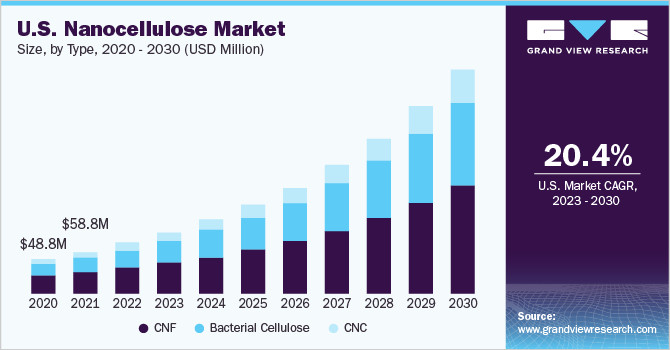Nanocellulose Market: A Growing Force in Packaging, Biomedical, and Electronics Industries
The global nanocellulose market is experiencing a surge in demand, driven by its versatile properties and environmental friendliness. This innovative material, derived from plant cellulose or wood pulp, is poised to revolutionize various industries, from packaging to biomedical applications.
Nanocellulose: A Material with Exceptional Properties
Nanocellulose is produced through a careful process of chemically or mechanically treating cellulose, a natural biopolymer readily available in nature. The resulting material boasts an impressive array of properties that make it a compelling alternative to traditional materials:
- High Strength and Stiffness: Nanocellulose fibers possess remarkable strength and stiffness, exceeding those of conventional materials like steel and aluminum on a weight basis. This makes it ideal for applications requiring high structural integrity, such as reinforcing composites and enhancing barrier properties in packaging.
- Biodegradability and Sustainability: Nanocellulose is a biodegradable and renewable material, making it a sustainable option for various applications. This aligns with the growing global focus on environmental responsibility and reducing reliance on non-renewable resources.
- Versatility: The versatility of nanocellulose shines through in its diverse applications. It can be incorporated into various materials, including plastics, polymers, and bio-based composites, to improve their properties, such as tensile strength, water resistance, and barrier performance. Its unique surface properties also make it suitable for use in coatings, adhesives, and filters.
Key Applications of Nanocellulose
The growing demand for nanocellulose is fueled by its diverse applications across various industries:
Packaging Industry
The packaging industry is a major consumer of nanocellulose, driven by the need for lightweight, high-barrier, and sustainable materials. Nanocellulose can be incorporated into packaging materials to enhance their barrier properties against moisture, oxygen, and grease, extending product shelf life. It also contributes to reducing material weight, leading to cost savings in transportation and reducing the environmental footprint of packaging.
Biomedical Applications
Nanocellulose's biocompatibility and biodegradability make it an ideal material for various biomedical applications. It is used in wound dressings, drug delivery systems, tissue engineering scaffolds, and medical implants. Nanocellulose's ability to promote cell growth and tissue regeneration holds immense potential in regenerative medicine and the development of new treatments.
Electronics Industry
Nanocellulose is emerging as a promising material in the electronics industry, specifically in flexible electronics and sensors. Its high conductivity, transparency, and flexibility make it suitable for developing transparent conductive films, sensors for flexible displays, and energy storage devices. These applications are driving significant research and development in the field, pushing the boundaries of nanocellulose's potential in the electronics industry.
Driving Factors for Nanocellulose Market Growth
The nanocellulose market is expected to experience substantial growth in the coming years, driven by several factors:
- Rising Demand for Sustainable Materials: Growing global concerns about environmental sustainability are driving the demand for eco-friendly and biodegradable materials like nanocellulose. Consumers are increasingly seeking products that are produced with minimal environmental impact, prompting manufacturers to adopt sustainable solutions, including nanocellulose.
- Technological Advancements: Advancements in nanotechnology and the development of efficient production methods for nanocellulose are making it more accessible and cost-effective. This is driving further innovation and the exploration of new applications for this versatile material.
- Growing Investments: Significant investments in research and development (R&D) are being made in the nanocellulose industry, further fueling its growth. This includes investments from both public and private sectors, demonstrating the potential and promising future of nanocellulose.
Key Players in the Nanocellulose Market
The nanocellulose market is dominated by a few key players, who are projected to hold about 45% of the market share. These leading players include Sappi, Nippon Paper Industries, GranBio, CelluForce Inc., American Process Inc., Anomera, and others. These companies are focusing on expanding their production capacities, investing heavily in innovation, and exploring new applications for nanocellulose, driving the market forward.
Future Outlook for the Nanocellulose Market
The future of the nanocellulose market looks promising, with experts predicting substantial growth in the coming years. As the demand for sustainable and high-performance materials continues to rise, nanocellulose is poised to become a key player in various industries. With ongoing research and development, we can expect to see even more innovative applications emerge, further expanding the market's potential.
The Bottom Line: Nanocellulose - A Material with a Brighter Future
Nanocellulose is a remarkable material with a wide range of applications that is rapidly gaining traction in various industries. Its exceptional properties, sustainability, and the growing investments in its development make it a material with a bright future. As we strive for a more sustainable and innovative future, nanocellulose will play a crucial role in revolutionizing various sectors, from packaging to biomedical applications and beyond.


















